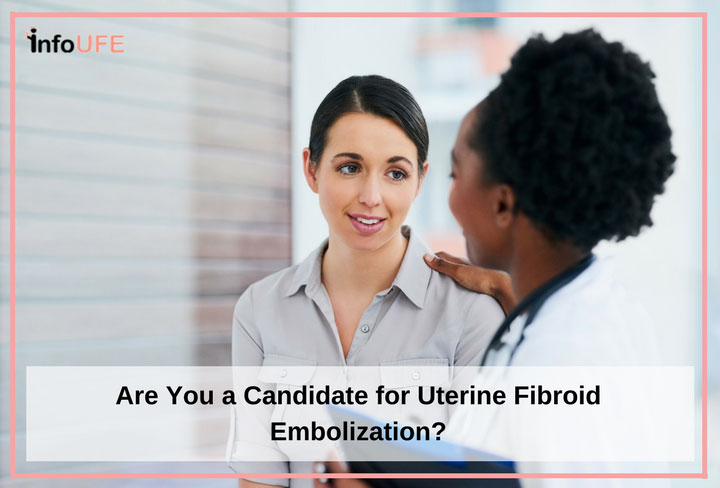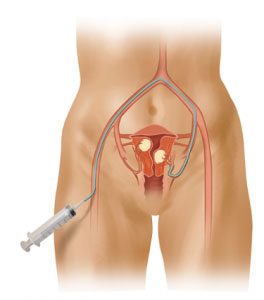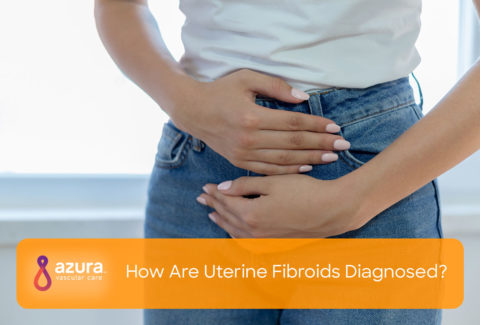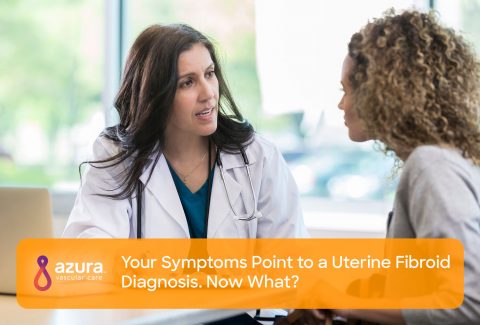
If you are experiencing pelvic pain or heaving bleeding and have been diagnosed with uterine fibroids, are you considering uterine fibroid embolization? Uterine fibroids, non-cancerous tumors of the uterus, can be treated without surgery for many women.
Understanding more about UFE can help determine if this is the right treatment option for you. UFE can be a successful option for relieving symptoms of uterine fibroids if you are a good candidate for the procedure.
Understanding Uterine Fibroid Embolization
 So, what is uterine fibroid embolization?
So, what is uterine fibroid embolization?
UFE is a minimally invasive procedure performed by an interventional radiologist. An interventional radiologist is a medical doctor who is trained to use x-ray technology to treat diseases without major surgery. The UFE procedure involves placing small FDA approved microspheres, or “beads” into the blood vessels supplying the fibroids to block the flow of oxygen and nutrients, causing them to shrink.
What to Know
UFE can be performed in a state-of-the-art outpatient center. Women undergoing UFE may be given medication for conscious sedation to alleviate pain and anxiety, but they are not completely unconscious for the procedure.
RELATED: 8 Things You Need to Know About the UFE Procedure
During the Procedure
During the procedure, an interventional radiologist places a long, thin catheter, a specialized tube, through a nick in the skin over the femoral (groin) or radial (wrist) artery. The catheter is maneuvered inside the artery while using fluoroscopy, (a form of x-ray). Next, the interventional radiologist advances the tip of the catheter into the arteries of the uterus that are feeding the fibroid. Contrast dye, a special dye that can be seen on x-rays, is injected through the catheter to identify the blood flow to the fibroids. Small beads are placed within the artery to block blood flow to the fibroids. This procedure is repeated for any other arteries that supply the fibroids. In the end, the catheter is removed and nothing more than a small bandage is placed over the nick.
Indications
UFE is indicated for the treatment of uterine fibroid symptoms. Such symptoms may include:
- Heavy Bleeding – This may be characterized by prolonged periods, very heavy bleeding, or irregular bleeding. This bleeding can result in anemia, or a significant lack of red blood cells.
- Pain – Pain can arise from the position of the fibroids within the uterus as well as compression on the other organs in the area. It can also be related to fibroid-size.
- Pressure Symptoms – If a fibroid pushes up against another organ, such as the bladder, it can cause problems, such as frequent urination. A large fibroid can also push against the rectum, creating problems with having a bowel movement.[i] [ii]
Contraindications to UFE
As with any procedure, there are contraindications, or reasons that the procedure may be advised against. Sometimes these are absolute, meaning that under no circumstances should the procedure be performed, and sometimes they are relative, or up to the patient and physician to determine. The most common contraindications for UFE are:
Absolute:
- Pregnancy – This is an absolute contraindication to UFE. It is not advisable to x-ray a pregnant uterus or to administer anything that will block the flow of blood to the uterus while pregnant.
- Allergy to Contrast Dye – Because this dye is needed during the procedure, an allergy may be a reason to avoid performing the procedure.
Relative:
- Chronic Kidney Disease – The contrast dye can be harmful to someone with poorly functioning kidneys. The decision to give contrast dye to a person with chronic kidney disease is made on an individual basis.
- Uncertain Pelvic Mass – If there is any question if the mass is something other than a fibroid, then UFE is not the appropriate procedure.
- Any Active Infection – Any procedure not related to treating the infection should be avoided, as the infection could worsen or spread. It may be possible to reconsider UFE after the infection has resolved.
- Asymptomatic Fibroids – UFE should not be performed unless the fibroids are causing symptoms that would indicate surgery.[i]
RELATED: What are the Risks of Uterine Fibroid Embolization
Fertility After UFE
UFE is minimally invasive and preserves the uterus. [i] Discuss any intention you may have to get pregnant after UFE with your interventional radiologist.
For many women, UFE can be a highly likely treatment option for uterine fibroids. Ultimately, you should review your medical history and goals with an interventional radiologist who is skilled at performing UFE to determine if you are an ideal candidate.
Sources:
[i] The Royal College of Obstetricians and Gynecologists and The Royal College of Radiologists, Clinical recommendations on the use of uterine artery embolization (UAE) in the management of fibroids. London: RCOG and RCR, 2013 https://www.rcog.org.uk/globalassets/documents/guidelines/23-12-2013_rcog_rcr_uae.pdf
[ii] Society of International Radiology, Uterine fibroids: symptoms, diagnosis and treatment. http://www.sirweb.org/patients/uterine-fibroids/


